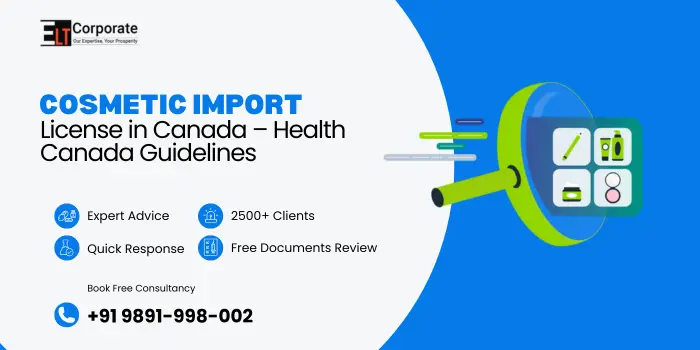The Challenges in the FMCG Sector have grown over the years, especially for brands dealing with cosmetics and personal care products. Importing cosmetics into Canada involves not just trade operations but also strict compliance with Health Canada regulations.
Unlike some countries that issue an official import license, Canada requires importers to follow the Food and Drugs Act and Cosmetic Regulations, ensuring product safety, correct labeling, and proper notification.
Failing to comply with these requirements can lead to delays, product refusals, or even penalties. This article explains how the cosmetic import process works in Canada, how businesses can handle the Challenges in the FMCG Sector while meeting Health Canada’s requirements, and what recent updates importers must know.
Laws and Regulatory Framework Governing Cosmetics Import License in Canada
Key laws and guidelines in governing cosmetics import license in canada include:
- Food and Drugs Act – defines cosmetics and gives Health Canada its authority.
- Cosmetic Regulations – rules about labelling, safety, notification, and prohibited ingredients.
- Cosmetic Ingredient Hotlist – list of substances that are banned or restricted, with required warnings.
These form the basis of regulatory compliance in the beauty and personal care segment of the FMCG sector.
Is There a Formal “Cosmetic Import License” in Canada?
- No. Instead of a single import license, importers must comply with Health Canada’s notification and labelling requirements. The key obligations are:
- Ensuring the product fits the legal definition of a cosmetic (not a drug or natural health product).
Submit a Cosmetic Notification Form (CNF) within 10 days of first sale in Canada, and provide product data to Health Canada.
Step-by-Step Import Process for Cosmetics in Canada
| S.No. | Step | You Should Do | Details & Important Notes |
|---|---|---|---|
| 1. | Confirm Product Classification | Determine whether your product is a cosmetic, drug, or other regulated item | Misclassification is a major barrier in the FMCG sector |
| 2. | Review Ingredient List vs Hotlist | Check each ingredient against the Cosmetic Ingredient Hotlist | Any prohibited or restricted ingredient must be addressed |
| 3. | Labeling & Language Requirements | Prepare labels in English & French, with product name, net quantity, manufacturer/importer address, and any warnings | From March 5, 2025, a Canadian address is mandatory in the CNF |
| 4. | Submit Cosmetic Notification Form (CNF) | Complete and submit online within 10 days after your first sale in Canada | Include formulation, concentrations, label visuals, intended use |
| 5. | Use Advance Notice of Importation (if needed) | If products require relabeling or modifications, apply under this process | Allows import under the condition of later corrections |
| 6. | Maintain Records & Documentation | Keep formulation data, batch records, safety data, and CNF copies | Records are essential for inspections or audits |
| 7. | Meet Border / Import Requirements | Ensure shipments comply with documentation and CNF at the Canada Border Services Agency (CBSA) | Non-compliance with documentation may lead to rejection |
Important Recent Regulatory Updates
- Canadian Address Requirement: Effective March 5, 2025, the CNF must include a Canadian address for the manufacturer or importer.
- Fragrance Allergen Disclosure: As of April 12, 2026, certain fragrance allergens present above thresholds must be disclosed on labels and included in CNF.
These changes add new layers of compliance for FMCG cosmetic importers and emphasise the importance of staying current on regulatory updates.
Common Challenges in the FMCG Sector When Importing Cosmetics
Some frequent challenges include:
- Suppliers are unwilling to share full ingredient concentration data needed for CNF.
- Incomplete or incorrect bilingual labelling, omitting the address or warnings.
- Regulatory changes (e.g. allergen disclosure) that force repackaging or relabeling.
- Border delays or refusals when documentation or notification is incomplete.
- Heavy administrative burden for documentation, formulation records, and audits.
These are key Challenges in the FMCG Sector when navigating cosmetic imports into Canada.
Practical Tips to Navigate These Challenges
To mitigate these challenges, consider:
- Working with trusted suppliers who provide transparent ingredient data.
- Designing your labels in English and French from the start, meeting upcoming allergen rules.
- Closely monitoring updates from Health Canada to stay ahead.
- Maintaining organised digital records for formulas, safety data, and CNFs.
- Engaging a Canadian regulatory specialist to guide you through compliance.
- Preparing for border scrutiny by aligning CNF data with import documentation.
What Happens if I Fail to Submit the Cosmetic Notification Form (CNF) on Time?
If you do not submit the CNF within 10 days of the first sale, Health Canada can refuse entry, remove the product from commerce, or take other compliance actions.
Are Fragrance Allergens Always Required to be Listed on Labels?
Yes – starting April 12, 2026, certain fragrance allergens above threshold levels must be listed on product labels and in the CNF.


Comments are closed